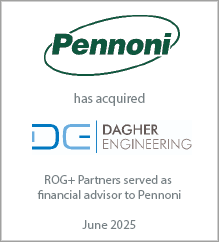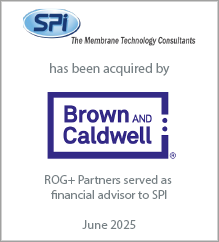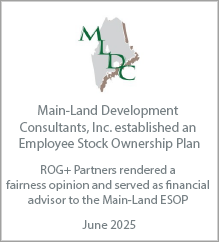With nearly fifteen years of corporate financial advisory experience, Jonathan Voelkel has worked with hundreds of engineering, architecture, and environmental consulting firms across the U.S. and abroad, in all facets of mergers & acquisitions, valuation, ownership transition planning, equity incentive compensation, and ESOP advisory. Jonathan received his Bachelor of Arts (BA) degree in Economics from Johns Hopkins University.
Don’t Let 2020 Be the Year That Got Away
January 28, 2020
The U.S. economy continues to surpass the milestone set last summer when gross domestic product eclipsed the previous 120-month record of uninterrupted growth set between 1991 and 2001. Initial results for the final quarter of 2019 will be published this week, and reports from economists indicate that the trend of GDP growth continued throughout the end of the year.
However, the same reports cited signs of an economic slowdown. Economists lowered growth projections due to reasons related to cyclical (reduced utility output resulting from warmer weather), policy (dollar-price increases facing households due to tariffs), and market-specific (manufacturing job growth decline) factors.
Many A/E firms have enjoyed extended growth over this boom period. The most common messages I’ve heard from clients over the past few years have been thematically similar, pointing to a modest amount of uncertainty about the future, coupled with having a “good kind” of problem, such as needing to turn down work as a result of not finding the right people to support growth.
The most recent Architecture Billings Index score released by the American Institute of Architects last week demonstrated a trend of improvement, marking December 2019 as the third consecutive month in which there was an increase in architectural billings. (The ABI score reflects a nine- to 12-month lead time between billings and construction spending, and is generally considered the leading indicator of construction activity in the U.S. A score higher than 50 represents positive growth over the previous month, whereas a score lower than 50 represents negative growth.) A statement made in the description of the most recent score strongly suggested that there were expectations for “balanced growth…[that] looks more positive for the coming year.” Of the various data analyzed in the calculation of the ABI score, the one considered the most accurate predictor of future design work is the dollar-value change of new design contracts, which are “agreements between the client and architecture firm on the scope of and compensation for the design activity.” This figure increased to 53.4 in December from 52.9 in November, lending further credence to the near-term strength of the design and construction markets.
The key points above about market uncertainty in an economy showing few signs of being derailed should seem familiar to those who remember the state of the A/E industry in the years leading up to the Great Recession.
But one significant consequence of the economic downturn that affected A/E firms was the setback of ownership transition planning. Some of the obstacles to continuing along with a successful transition were unavoidable: the rough economics encompassing most of the industry led not only to a drastic drop in shareholder value, but also to a lack of participants willing or able to help further the goals of such plans.
Knowing all this, and based on what I’ve gathered from discussions with A/E firm leaders, here are my recommendations for 2020, a year that I hope my clients won’t look back upon as the “year that got away.”
Effective Systems and Financial Controls
Are the systems and controls your firm has set in place the right ones to ensure the best interests of your firm’s clients and employees? Whether it’s a corporate governance plan that allows the firm to act quickly and efficiently in a fluctuating environment – or industry-standard financial reporting that puts management in the right position to accurately identify and work on the highs and lows of the expected volatility that typically impact financial performance. Solidifying these systems and controls now will mean that your firm’s leadership won’t be forced to address unexpected problems regularly, thereby allowing them to continue focusing on organizational success.
Sustaining Operations
A/E firm owners know that withdrawing from the hands-on nature of design and consulting work with clients does not necessarily translate to withdrawing from the relationships that brought their companies’ repeated success. Often the opposite is true, and those owners build stronger, deeper bonds with their clients from a different perch. Savvy owners realize that there are fewer risks to the sustainability of their company’s success the less relied-upon they are. Take a closer look at the factors that affect the sustainability of your firm’s operations, and begin charting ways to decrease the dependence on relationships that contribute to continued sustainability.
Broadened Sharing of Responsibilities
The lighter the concentration of responsibilities among a firm’s owners, the better the chances are that the firm will weather a transition well after its key people are gone. Ownership teams with clearly defined duties spread widely across the team are not going to be affected the same way as teams with company obligations heavily concentrated among a few. Create a system that measures the performance and make sure that responsibilities are clear. It doesn’t matter if the division of labor regarding these is managed post-transition the way it was pre-transition. What matters is that there’s an understanding of what the responsibilities are – and that they’re easily assignable before and during a transition to minimize potential setbacks.
Next Steps
Use the fresh start to the New Year (and new decade!) as a springboard to act. The recommendations above are well-suited for all firms, and even though you might think your firm will continue to head in the right direction for the foreseeable future, there’s never a wrong time to assess or reassess the strategies your firm has relied on in the past.
However, the same reports cited signs of an economic slowdown. Economists lowered growth projections due to reasons related to cyclical (reduced utility output resulting from warmer weather), policy (dollar-price increases facing households due to tariffs), and market-specific (manufacturing job growth decline) factors.
Many A/E firms have enjoyed extended growth over this boom period. The most common messages I’ve heard from clients over the past few years have been thematically similar, pointing to a modest amount of uncertainty about the future, coupled with having a “good kind” of problem, such as needing to turn down work as a result of not finding the right people to support growth.
The most recent Architecture Billings Index score released by the American Institute of Architects last week demonstrated a trend of improvement, marking December 2019 as the third consecutive month in which there was an increase in architectural billings. (The ABI score reflects a nine- to 12-month lead time between billings and construction spending, and is generally considered the leading indicator of construction activity in the U.S. A score higher than 50 represents positive growth over the previous month, whereas a score lower than 50 represents negative growth.) A statement made in the description of the most recent score strongly suggested that there were expectations for “balanced growth…[that] looks more positive for the coming year.” Of the various data analyzed in the calculation of the ABI score, the one considered the most accurate predictor of future design work is the dollar-value change of new design contracts, which are “agreements between the client and architecture firm on the scope of and compensation for the design activity.” This figure increased to 53.4 in December from 52.9 in November, lending further credence to the near-term strength of the design and construction markets.
The key points above about market uncertainty in an economy showing few signs of being derailed should seem familiar to those who remember the state of the A/E industry in the years leading up to the Great Recession.
But one significant consequence of the economic downturn that affected A/E firms was the setback of ownership transition planning. Some of the obstacles to continuing along with a successful transition were unavoidable: the rough economics encompassing most of the industry led not only to a drastic drop in shareholder value, but also to a lack of participants willing or able to help further the goals of such plans.
Knowing all this, and based on what I’ve gathered from discussions with A/E firm leaders, here are my recommendations for 2020, a year that I hope my clients won’t look back upon as the “year that got away.”
Effective Systems and Financial Controls
Are the systems and controls your firm has set in place the right ones to ensure the best interests of your firm’s clients and employees? Whether it’s a corporate governance plan that allows the firm to act quickly and efficiently in a fluctuating environment – or industry-standard financial reporting that puts management in the right position to accurately identify and work on the highs and lows of the expected volatility that typically impact financial performance. Solidifying these systems and controls now will mean that your firm’s leadership won’t be forced to address unexpected problems regularly, thereby allowing them to continue focusing on organizational success.
Sustaining Operations
A/E firm owners know that withdrawing from the hands-on nature of design and consulting work with clients does not necessarily translate to withdrawing from the relationships that brought their companies’ repeated success. Often the opposite is true, and those owners build stronger, deeper bonds with their clients from a different perch. Savvy owners realize that there are fewer risks to the sustainability of their company’s success the less relied-upon they are. Take a closer look at the factors that affect the sustainability of your firm’s operations, and begin charting ways to decrease the dependence on relationships that contribute to continued sustainability.
Broadened Sharing of Responsibilities
The lighter the concentration of responsibilities among a firm’s owners, the better the chances are that the firm will weather a transition well after its key people are gone. Ownership teams with clearly defined duties spread widely across the team are not going to be affected the same way as teams with company obligations heavily concentrated among a few. Create a system that measures the performance and make sure that responsibilities are clear. It doesn’t matter if the division of labor regarding these is managed post-transition the way it was pre-transition. What matters is that there’s an understanding of what the responsibilities are – and that they’re easily assignable before and during a transition to minimize potential setbacks.
Next Steps
Use the fresh start to the New Year (and new decade!) as a springboard to act. The recommendations above are well-suited for all firms, and even though you might think your firm will continue to head in the right direction for the foreseeable future, there’s never a wrong time to assess or reassess the strategies your firm has relied on in the past.








